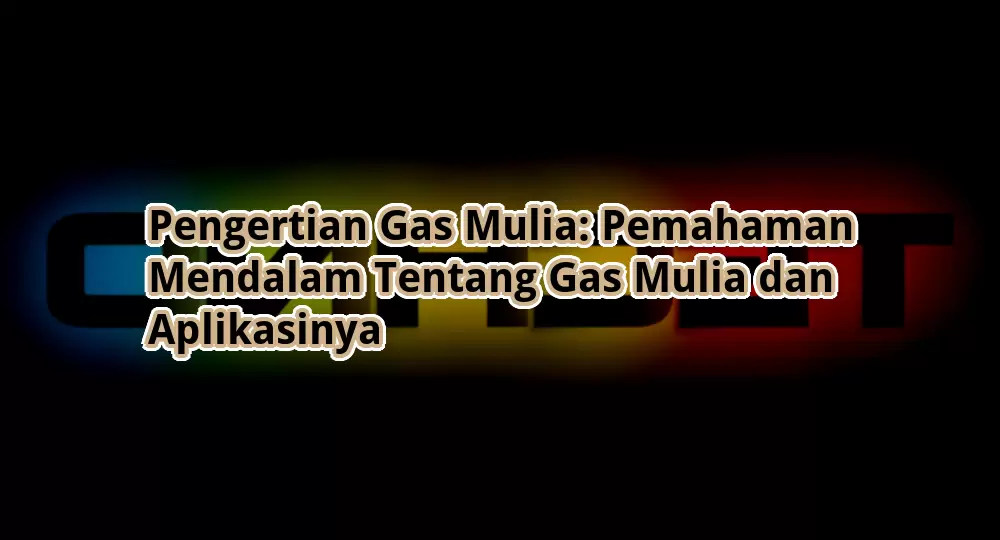
Pengertian Gas Mulia: Unveiling the Wonders of Noble Gases
Greeting the Audience: Hello, zflas.co!
? In this informative journal article, we will explore the fascinating world of “pengertian gas mulia” or noble gases. These elements, found in the periodic table, possess unique properties and play crucial roles in various scientific applications. Join us on this captivating journey as we delve into the definition, strengths, weaknesses, and practical uses of these remarkable gases. Let’s begin!
Introduction: Understanding Noble Gases
? Noble gases, also known as inert gases, are a group of elements that exhibit low reactivity due to their stable electron configurations. This group includes helium (He), neon (Ne), argon (Ar), krypton (Kr), xenon (Xe), and radon (Rn). These gases are odorless, colorless, and tasteless, making them stand out among other elements.
? The unique properties of noble gases stem from their full outer electron shells, making them highly stable. This stability renders them largely unreactive, resulting in their classification as inert. However, this characteristic also limits their reactivity, making it challenging to utilize them in certain chemical reactions.
? Despite their low reactivity, noble gases possess several extraordinary qualities that make them invaluable in various fields of science and technology. Let’s explore the strengths and weaknesses of these remarkable elements.
Strengths of Noble Gases
1️⃣ Low Reactivity: Noble gases’ stability and low reactivity make them ideal for applications requiring non-reactive environments. They are commonly used in laboratories and industrial processes to create controlled atmospheres.
2️⃣ High Thermal Stability: These gases exhibit excellent thermal stability, allowing them to withstand extreme temperatures. This property makes them vital in applications involving high-temperature processes, such as lighting and welding.
3️⃣ Luminescent Properties: Noble gases can emit light when an electric current or energy is applied. This characteristic is extensively used in lighting technologies, such as neon signs, fluorescent lamps, and plasma displays.
4️⃣ Medical Applications: Helium, a noble gas, is widely used in medical imaging systems like MRI machines due to its low density and non-reactivity. It also finds application in cryogenics and respiratory therapies.
5️⃣ Energy Efficiency: Noble gases are crucial in energy-efficient lighting, such as compact fluorescent lamps and light-emitting diodes (LEDs). These gases facilitate the production of bright and long-lasting light sources.
6️⃣ Shielding and Insulation: Certain noble gases, like argon and xenon, are commonly used as insulating materials in windows and electronic devices. They provide excellent thermal insulation and act as a barrier against unwanted heat transfer.
7️⃣ Industrial Applications: Noble gases find extensive use in diverse industrial sectors, including cryogenics, manufacturing, and electronics. They are employed in processes like welding, laser cutting, and semiconductor fabrication.
Weaknesses of Noble Gases
1️⃣ Limited Availability: Noble gases are relatively scarce in the Earth’s atmosphere, making them challenging and expensive to extract. The extraction process involves complex technologies and requires significant energy consumption.
2️⃣ High Cost: Due to their limited availability and complex extraction methods, noble gases tend to be expensive. This factor restricts their widespread use in certain applications, particularly those with lower budgets.
3️⃣ Limited Reactivity: While their low reactivity is a strength in some applications, it can also be a drawback. Noble gases’ unreactive nature makes it difficult to incorporate them into chemical reactions, limiting their use in certain chemical processes.
4️⃣ Environmental Impact: The production and extraction of noble gases may have environmental consequences. It is crucial to implement sustainable practices and find alternative sources to mitigate any potential negative impact.
5️⃣ Difficult to Contain: Noble gases have low boiling points, making them challenging to store and transport. Specialized containers and cryogenic techniques are required to handle these gases safely.
6️⃣ Limited Applications: Despite their remarkable properties, noble gases have specific applications and are not universally applicable. Their use is predominantly in scientific research, industry, and specialized technologies.
7️⃣ Safety Concerns: Some noble gases, like helium and radon, have safety considerations associated with their usage. Proper safety protocols must be followed to prevent any potential risks.
Table: Complete Information about Pengertian Gas Mulia
| Element | Symbol | Atomic Number |
|---|---|---|
| Helium | He | 2 |
| Neon | Ne | 10 |
| Argon | Ar | 18 |
| Krypton | Kr | 36 |
| Xenon | Xe | 54 |
| Radon | Rn | 86 |
Frequently Asked Questions (FAQs) About Pengertian Gas Mulia
1. What are noble gases?
Noble gases are a group of elements with low reactivity and stable electron configurations.
2. How many noble gases are there?
There are six noble gases: helium, neon, argon, krypton, xenon, and radon.
3. What are the unique properties of noble gases?
Noble gases are odorless, colorless, and tasteless. They have full outer electron shells, making them stable and unreactive.
4. Where are noble gases found?
Noble gases are present in the Earth’s atmosphere in trace amounts. They can also be extracted from natural gas and certain minerals.
5. What are the practical applications of noble gases?
Noble gases are used in lighting technologies, cryogenics, medical imaging, welding, and various industrial processes.
6. Are noble gases dangerous?
Noble gases are generally safe when handled properly. However, certain gases like helium and radon may pose safety concerns if not used with caution.
7. Can noble gases react with other elements?
While noble gases are generally unreactive, they can form compounds under specific conditions. However, these compounds are rare and unstable.
8. How are noble gases extracted?
Noble gases are extracted from the Earth’s atmosphere and natural gas through complex processes involving liquefaction and separation techniques.
9. Can noble gases be used as fuels?
Noble gases are not typically used as fuels due to their low reactivity. However, they can be used in specialized combustion processes and as propellants.
10. Are noble gases renewable resources?
No, noble gases are not considered renewable resources. Their limited availability and extraction difficulties make them finite resources.
11. Can noble gases be used in medicine?
Yes, noble gases like helium have medical applications, particularly in medical imaging and respiratory therapies.
12. What is the environmental impact of noble gas extraction?
Noble gas extraction may have environmental consequences, such as energy consumption and potential emissions. Sustainable practices and alternative sources should be explored.
13. Are noble gases used in space exploration?
Noble gases have been used in space exploration for various applications, including propulsion systems, life support, and scientific experiments.
Conclusion: Embrace the Potential of Noble Gases!
? In conclusion, pengertian gas mulia or noble gases offer a wealth of possibilities in scientific research, industry, and technological advancements. Their low reactivity, thermal stability, and luminescent properties make them indispensable in various applications.
? As we continue to unravel the secrets of noble gases, it’s crucial to explore sustainable extraction methods and expand their potential uses. By harnessing the strengths of noble gases and addressing their weaknesses, we can unlock new frontiers, improve energy efficiency, and revolutionize numerous fields.
? So, let’s embrace the wonders of pengertian gas mulia and unleash their full potential for a brighter future!
Closing Words and Disclaimer
? In this journal article, we have endeavored to provide comprehensive information about pengertian gas mulia or noble gases. However, it’s essential to note that scientific understanding and advancements are constantly evolving. Therefore, it is recommended to refer to reputable sources and consult experts for the most up-to-date information.
? Furthermore, while noble gases offer numerous benefits, it is crucial to implement sustainable practices and consider environmental impacts. The responsible use of these valuable resources will contribute to a more sustainable and eco-friendly future.
? Thank you for joining us on this enlightening journey through the world of pengertian gas mulia. We hope this article has broadened your knowledge and inspired you to explore the fascinating realm of noble gases further. Together, let’s continue to unravel the mysteries of the universe and harness the power of science for the betterment of humanity.
